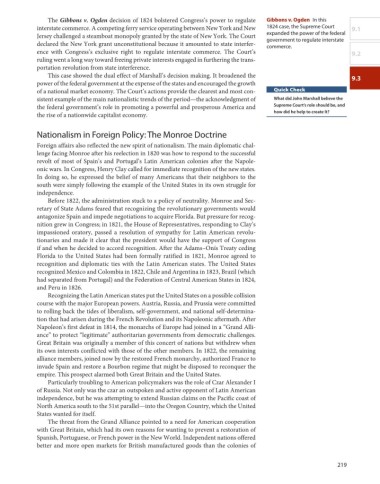Page 252 - American Stories, A History of the United States
P. 252
The Gibbons v. Ogden decision of 1824 bolstered Congress’s power to regulate Gibbons v. ogden In this
interstate commerce. A competing ferry service operating between New York and New 1824 case, the Supreme court 9.1
Jersey challenged a steamboat monopoly granted by the state of New York. The Court expanded the power of the federal
government to regulate interstate
declared the New York grant unconstitutional because it amounted to state interfer- commerce.
ence with Congress’s exclusive right to regulate interstate commerce. The Court’s 9.2
ruling went a long way toward freeing private interests engaged in furthering the trans-
portation revolution from state interference.
This case showed the dual effect of Marshall’s decision making. It broadened the 9.3
power of the federal government at the expense of the states and encouraged the growth
of a national market economy. The Court’s actions provide the clearest and most con- Quick Check
sistent example of the main nationalistic trends of the period—the acknowledgment of What did John Marshall believe the
the federal government’s role in promoting a powerful and prosperous America and Supreme Court’s role should be, and
the rise of a nationwide capitalist economy. how did he help to create It?
Nationalism in Foreign Policy: The Monroe Doctrine
Foreign affairs also reflected the new spirit of nationalism. The main diplomatic chal-
lenge facing Monroe after his reelection in 1820 was how to respond to the successful
revolt of most of Spain’s and Portugal’s Latin American colonies after the Napole-
onic wars. In Congress, Henry Clay called for immediate recognition of the new states.
In doing so, he expressed the belief of many Americans that their neighbors to the
south were simply following the example of the United States in its own struggle for
independence.
Before 1822, the administration stuck to a policy of neutrality. Monroe and Sec-
retary of State Adams feared that recognizing the revolutionary governments would
antagonize Spain and impede negotiations to acquire Florida. But pressure for recog-
nition grew in Congress; in 1821, the House of Representatives, responding to Clay’s
impassioned oratory, passed a resolution of sympathy for Latin American revolu-
tionaries and made it clear that the president would have the support of Congress
if and when he decided to accord recognition. After the Adams–Onís Treaty ceding
Florida to the United States had been formally ratified in 1821, Monroe agreed to
recognition and diplomatic ties with the Latin American states. The United States
recognized Mexico and Colombia in 1822, Chile and Argentina in 1823, Brazil (which
had separated from Portugal) and the Federation of Central American States in 1824,
and Peru in 1826.
Recognizing the Latin American states put the United States on a possible collision
course with the major European powers. Austria, Russia, and Prussia were committed
to rolling back the tides of liberalism, self-government, and national self-determina-
tion that had arisen during the French Revolution and its Napoleonic aftermath. After
Napoleon’s first defeat in 1814, the monarchs of Europe had joined in a “Grand Alli-
ance” to protect “legitimate” authoritarian governments from democratic challenges.
Great Britain was originally a member of this concert of nations but withdrew when
its own interests conflicted with those of the other members. In 1822, the remaining
alliance members, joined now by the restored French monarchy, authorized France to
invade Spain and restore a Bourbon regime that might be disposed to reconquer the
empire. This prospect alarmed both Great Britain and the United States.
Particularly troubling to American policymakers was the role of Czar Alexander I
of Russia. Not only was the czar an outspoken and active opponent of Latin American
independence, but he was attempting to extend Russian claims on the Pacific coast of
North America south to the 51st parallel—into the Oregon Country, which the United
States wanted for itself.
The threat from the Grand Alliance pointed to a need for American cooperation
with Great Britain, which had its own reasons for wanting to prevent a restoration of
Spanish, Portuguese, or French power in the New World. Independent nations offered
better and more open markets for British manufactured goods than the colonies of
219

